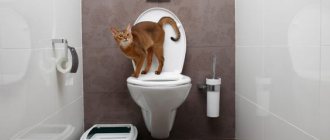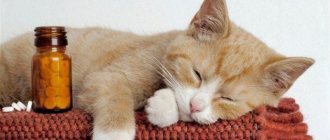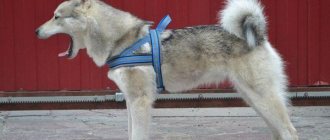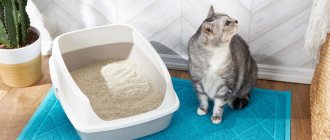A harness for cats is a very convenient device that is designed to accustom your beloved pet to walks. So if your furry pet is bored within the walls of a cramped apartment, it’s time to go outside. However, this is not as simple as it seems. For some cats, leaving the house is a real stress. In order not to injure your pet’s nervous system, you should accustom him to walks gradually. And you need to start by getting to know the ammunition. How to accustom a cat to a harness, how to make the right choice?
How to train a cat to wear a harness
Protective equipment and choice of ammunition
In nature, pets face various troubles - infections, rabid animals, blood-sucking insects. Therefore, the cat must be protected from parasites - fleas and ticks. To do this you need to buy protective equipment:
- collar;
- drops;
- antiparasitic shampoos.
You will also need to get all the necessary vaccinations - on the street, your pet may encounter sick animals and become infected with various dangerous infections.
Choice of ammunition. After the cat’s body is ready to resist diseases and blood-sucking insects, it is necessary to buy walking equipment:
- Selecting an accessory . A cat needs a harness, not a collar. The cat's neck muscles are not strong enough, and any sudden movement can damage the cervical vertebrae. The harness should be strong, light, and safe. It should be easy to put on and adjust. The size of the harness should be such that 2 fingers can be inserted between it and the pet’s body. Then it will securely fix the animal, but will not press or rub.
- The optimal material option . The best material for cat gear is synthetic or cotton fiber. This “harness” is light, washes well and has no odor that might frighten a cat.
- The leash to the harness must be fastened securely so that the cat cannot break free and run away. For walking, a leash length of 1.5-2 m or a roulette leash for small breed dogs is sufficient.
What is better to use for a walk: a harness or a collar?
The harness for walking cats is made very conveniently: its strap is located around the animal’s body on the back in the area of the shoulder blades. Fastens tightly with clasps on the stomach or neck. The leash is secured using a ring.
A cat should not be walked with a simple collar. The structure of her cervical vertebrae is very fragile and they can be damaged by sudden movements of the leash. The collar can be useful as a decorative decoration or as a flea control, and you can attach a sign to it with the name and address of the cat's owner if for some reason the cat gets lost.
Practical advice
Problems you may encounter.
- The cat does not master the harness stage, licks the fur under it, and fusses. Most likely, a clean animal is simply concerned about the condition of its coat, so while mastering this stage, brush your pet regularly.
- The animal is actively trying to get rid of the ammunition with the help of its teeth and paws. The problem may be that its size is chosen incorrectly, the harness rubs and presses, and interferes with natural movements. Remember that 2 fingers should comfortably fit under the collar and harness at any angle.
- The pet is scared. It is possible that the equipment (harness, leash, collar) contains sharp fittings, bells or other irritating factors.
- Wild panic when going outside, the animal tries to hide and even begins to scratch the owner when he tries to lower him to the ground. In this case, walking is out of the question. Perhaps your pet’s “ultimate dream” is a windowsill where you can safely study flying birds and insects.
Cats are very smart animals, so it is not difficult to accustom even an adult to a leash and takes at most 1-2 months. It is important to show patience and affection towards your pet at every stage.
how to train a cat to use the litter box
Does a cat need to go for a walk?
There is an opinion that walking dogs is mandatory, but what about cats? Do they need to go outside from time to time?
Of course, it would be wrong to compare cats with dogs. Apart from the presence of four legs and a tail, animals have nothing else in common - neither character, nor habits, nor taste preferences. What about walks? Of course, if your cat has been sitting at home for several years, then it is likely that the prospect of going outside will not please her, even despite the fact that she spends all day on the windowsill and sighs languidly, watching the bird.
Preventing excess weight for spayed or neutered pets
Many veterinarians say that cats need to go outside to eat grass. It is known that it cleanses their stomach of unnecessary contents and allows them to normalize intestinal motility. In addition, green grass is a good source of vitamins and improves mood. Therefore, this is a strong argument in favor of walking.
Cat on a walk in a harness
He's not alone. Here's another. Everyone knows that every living creature on earth needs oxygen. A cat constantly sitting at home with the windows closed will obviously feel unwell. And this will manifest itself in weakness, reluctance to play and even eat. Therefore, owners who are against walking need to take utmost care to ensure that the pet receives enough oxygen. To do this, you need to regularly ventilate the room and open all the windows wide for half an hour at least several times a day. It's great if your apartment has a balcony. If you take the fluffy out on it at least several times a day, this will eliminate the need for walks.
Another important point: love for warmth. Surely, many owners have noticed that their pets are always near heat sources - a radiator, a stove. And some cats simply love to soak up the sun on the windowsill. And this is not because they need vitamin D, no, unlike humans, they can do just fine without it. They only need warmth, because without it, according to veterinarians, the cat may die.
Furry fidgets on the street may also like tempting rustling leaves, twigs moving quickly under the pressure of the wind, birds, butterflies, midges flying near their noses, and many other things that are attractive to cats.
Cat enjoying nature
However, everything is not so rosy. There are also several arguments that can convince cat owners to take them outside. This is a high probability of injury. This is often caused by motor vehicles. Despite the caution of cats, some of them, due to their timidity, still end up under wheels, receiving serious injuries. The same applies to meeting a dog, which, following its natural instincts, may unexpectedly attack a walking cat nearby.
Poisoning is another reason not to let your cat outside. Cats, by nature, are true hunters. Therefore, she will never refuse the opportunity to feast on a caught rat, mouse, bird or poisonous beetle. It is impossible to exclude the strange love of cats for garbage containers. Next to a tempting piece of meat there may be a chemical reagent that will penetrate the stomach and cause severe symptoms of intoxication in the form of nausea, vomiting, diarrhea and dehydration.
Cats are real hunters
No less dangerous are poisonous plants and exhaust gases, which also cause serious poisoning. All these troubles can be avoided if you accompany your cat on a walk, walk where it is clean, as quiet and safe as possible, and control his actions. And if you put a harness or leash on your pet, then she will definitely not be afraid of any danger.
Durable harness for walking
Who gets used to a leash easier?
Leash training can take quite a long time. You should be patient and not force things.
The younger the animal, the easier it gets used to the leash.
The kitten perceives training as a game and quickly gets used to the harness and leash. You should take into account not only the age, but also the breed of the cat. Cats with a “dog-like” character learn to walk on a leash more easily, for example:
- Maine Coon;
- munchkin;
- Abyssinian and Somali cats;
- Manx cat;
- American Curl;
- Turkish van;
- Devon Rex;
- oriental cat;
- Bengal cat;
- California speckled;
- savannah.
With the right amount of patience and approach, you can train any cat to use a leash. Training should be built taking into account the character and temperament of the pet and the training period should be divided into stages.
How to choose the right size
Most collars you can buy in stores come in a standard size. In addition, they always have a length adjuster, so you can adjust the product specifically to your pet’s neck.
However, before you buy a strap for your pet, it is better to take measurements of its neck. To do this, take a soft meter tape and measure the circumference of your neck. Add another 1-2 cm to the resulting figure, and with this data go shopping. It is desirable that there is a gap of 1.5-2 cm between the product and the animal’s neck, which can be easily checked by inserting one or two fingers (index and middle) between the strap and the neck.
The collar should not fit too tightly on the cat, otherwise it risks suffocation, damage to the cervical vertebrae and chafing. But it shouldn’t be too loose, because if an animal can easily stick its head through the ring and slip out, then there is no point in such a product.
Important! It is recommended to choose collars for cats with soft, rounded side edges. This will keep your pet's long fur in its natural state, preventing it from being rubbed off by the sharp edges of the strap. For short-haired cats and cats without hair, this will avoid chafing of the skin.
It is best to choose a product that is narrow and smooth on the inside, made from high-quality natural materials.
Stage 1. Getting to know each other
An independent character and freedom-loving habits prevent rapid adaptation to any restrictions. Therefore, the leash should be associated with pleasant emotions - play, rest, feeding. The harness and leash should be placed next to the feeding trough or sleeping place. Let your pet sniff and touch the new thing. Ammunition should not evoke negative emotions - only positive or neutral ones.
The introduction should continue until the cat gets used to the equipment. This stage may take 1-2 days. After the acquaintance has taken place, you can proceed to the next stage.
At what age is it best to teach
Veterinarians agree that it is necessary to accustom a cat to a leash at an early age, then resistance to training is less and the animal quickly gets used to the new accessory. However, you cannot put a collar on kittens that have not yet reached six months of age. In childhood, cats have a very fragile skeleton, the cervical vertebrae are weak, so even an accidental careless action by the kitten in the strap can cause a neck injury and even lead to death.
Thus, the best time to accustom your pet to a collar is from the age of six months. It’s also not worth delaying training, since adult individuals are more zealous in resisting training and do not want to accept a new accessory for a long time.
Find out in more detail how to make your own scratching post, house and toy for your pet, as well as how to sew a blanket, choose a carrier and clothes for your cat.
For needlewomen
Is the door on your baby carrier broken? The car has stalled, but it’s high time to take your pet out for toilet chores? DIY cat harness in an emergency - quick and easy. For one-time use only in case of emergency!
Any thong, not a thick rope, or even (don’t laugh) a woman’s stocking will do for this purpose. Fold the “rope” in half and place the middle on top of the neck, then cross the ends and bring them under the front legs. All that remains is to tie the ends on the back and secure with a knot. The place where the ends cross (in front of the chest) needs to be tied with a string or elastic band so that the “crosshair” does not creep towards the throat.
A reliable DIY cat harness is made from two collars and a piece of leash. The collars should be the right size - one smaller, one larger. The upper part is connected with a jumper from a piece of leash - and you're done. Don't forget to attach the carabiner ring. If you choose collars and a leash of the same series, the harness will turn out exactly the same as in the first picture.
What to consider when buying a harness
The first thing to consider when purchasing is the material from which the harness is made. Your cat may not like a heavy, stiff leash. She will try to throw off the burden.
In order not to limit freedom of movement, it is better to choose a long leash (two meters or more). It is most convenient to use an adjustable leash-roulette.
Stage 2. Getting used to the harness
For the next step, you need to stock up on patience and treats. It is important not to scare the animal. We put the harness on for just a few minutes. If it is made in the form of a vest, then the process should not cause difficulties. And if it is a system of belts, then you should first figure out the device yourself, so as not to scare your pet with an unsuccessful attempt.
The cat, depending on its temperament, may try to escape, remove unusual equipment, or pretend to be dead. You cannot scold your pet, you should caress it, give it a treat, and play with it. You need to distract the cat from unpleasant sensations. Gradually, the time in the harness should be increased. This stage may take another week.
Teaching a cat to walk on a leash
So, your cat has become accustomed to the harness, which will take you 2 to 4 weeks. The animal calmly allows you to put on the equipment (for which it receives a treat), calmly wears the accessory for 2–3 hours, washes itself and sleeps in a harness. Great! It's leash time, remember - take your time! A cat won't do anything it doesn't like.
Important! Don't let your animal play with the equipment!
We fastened the carabiner of the leash, noticed a misunderstanding on the animal’s face and began “distracting maneuvers” - we pick it up, play, treat it with treats, comb its fur. Wear a leash whenever you are going to do anything with your pet. After a few days, we take the cat, take it to the corridor or another room, fasten the leash and go to the kitchen. We put food on the table and call the pet to eat - the food instinct is stronger than any inconvenience, the pet will come running, dragging the leash behind it.
Stage 3. Fasten the leash
Is the cat completely accustomed to the harness, calmly reacting to its presence, the process of putting it on? Now it’s the leash’s turn. At first, you should not touch him - let him freely drag behind the animal. The leash should only be attached for a short time. The animal can move freely with it, but you need to make sure that the leash does not get tangled or caught on furniture.
Finally, the time comes to walk the cat on a leash around the apartment. The animal can choose its own pace and route. You should not pull the leash and force the pet to go where the owner wants. On the street, most likely, it will be the same - not the owner walking the cat, but the cat of its owner. A pet obediently walking next to a person is a picture from the realm of a pipe dream.
Popular harness models
The market offers quite a lot of models of harnesses for cats. Having studied the offers of some online stores and analyzed the quality characteristics of various products, we offer our rating of cat harnesses.
Table 2. Comparative characteristics of cat harness models.
| Name | Characteristics | Dimensions | Advantages | Flaws |
| Model from TRIXIE | Harness with stripes that reflect light. The set includes a leash, which is attached to the harness with a durable metal carabiner | Strap width – 1 cm. Chest circumference – 22×42 cm |
| Flashing stripes can frighten an animal |
| Model from ReflectoCat S Rogz | Made from polyester. The set includes a leash, the length of which is 1 m 80 cm. The fasteners are made of acetate plastic. They are very strong. When opened, the animal's fur does not come off and is not damaged. The carabiner connecting the leash to the harness opens with significant tension. This allows you to unfasten it when the animal climbs a high fence and tree. The product is bright, beautiful, the set includes bells | Strap width – 1.1 cm. Size – S |
|
|
| Model from DEZZIE, created for kittens | Nylon based material. The set includes a leash 1 meter 20 cm long | The width of the straps is 0.8 cm. The chest circumference is 21x34 cm. |
| |
| Model Hunter Smart from Strips | Made from nylon. The kit includes a leash 120 cm long. The dimensions are adjusted using plastic sliders on the slots | Strap width – 0.8 cm. Chest circumference – 22×46 cm, neck circumference – 22×33 cm |
| Narrow straps |
| Trixie model for kittens and small cats | Made of artificial leather. The set includes a leash 1.2 m long | Strap width 0.8 cm. Bust circumference – 22×32 cm, neck circumference – 22×28 cm |
| You will have to buy a new harness when the animal grows up |
The basic rule for walking furry pets is that the cat is not the owner. The cat must walk the owner. Therefore, do not pull the leash or drag the animal in the opposite direction. If this place is dangerous, just pick him up and take him to another place. You should not prohibit your pet from exploring the territory.
Stage 4. Choose a place and time for a walk
The first walk should be carefully thought out by the owner:
- Place . A cat that has never been outside its familiar environment will most likely become frightened and protest. Therefore, you should carefully choose your walking route. There should be no dogs, street cats, or crowds of people nearby. We choose a calm, quiet place, away from the noise of cars. There should be no dense bushes or tall trees nearby. Otherwise, you will have to pull your pet out of the bushes or climb trees after it (read more about how to remove a cat from a tree).
- Habituation and familiarization . You need to wait until the cat himself expresses a desire to come down to the ground. Planting it in tall grass will make the cat feel more protected. Stroke the pet, talk, encourage. The cat will sit in one place for a long time. Don't be nervous - he needs time to get comfortable, sniff everything, and calm down. As soon as the cat calms down, he will begin to choose his own route for a walk. If the owner does not like following the pet along the “cat path,” he needs to stop. Do not pull the leash, do not scold the cat and do not get nervous. Sooner or later, the animal will get tired of trying to redirect the person, and it will go in the right direction.
- Time . If there are no such quiet places near your home, then you can choose a convenient time - in the morning or in the evening.
A walk should be enjoyable for both the owner and the furry pet.
About ½ of domestic cats do not enjoy walking on a leash.
In this case, you need to come to terms with it. Such a “homebody” may well have enough impressions and fresh air through an open and screened window.
Also watch the video on how to teach a cat to walk on a leash:
Which cats should not be walked, and who needs it?
The fact that fresh air has never harmed anyone is obvious. The oxygen received during walks saturates the brain and improves the functioning of all internal organs. And there is no need to talk about the benefits of physical activity for domestic couch potatoes. To make your cat's walk as safe as possible, you should follow the following rules:
- the cat must have all vaccinations;
- you need to take preventive measures in advance to protect your pet from fleas, ticks, and lice;
- Buy a harness or leash.
Walking is strictly prohibited for such cats.
- Kittens up to 5 months old, who, for either physical or psychological reasons, cannot conquer the outside world. In addition, at this age, many vaccinations that are simply necessary for safe walks are contraindicated. It is necessary to organize an exit to the street only after all the necessary injections have been completed.
- Pregnant pets.
- Weakened, sick cats, or those who have recently suffered from an illness and are not yet strong enough.
- Pets are very shy and afraid of noise and bright light.
- Overly aggressive cats (especially during heat). When they see another animal, they will always want to fight with it. And you don’t need this at all. The best option in this case is to walk where there are no other animals.
- Cats over 5 years old who have not previously gone outside.
Walks will be useful for hyperactive and courageous cats. You will definitely like the diversity of the surrounding world. And they are unlikely to deny themselves the pleasure of repeating this wonderful moment after some time.
If your cat managed to escape through an open window to nibble grass, don’t scold her for it. It’s better to organize joint walks.
Cat eats grass
It will be useful to shake up pets who used to be hyperactive, but have recently become lazy and began to spend most of their time on the couch. Perhaps the lack of oxygen is to blame. Try going out into the fresh air with him. This will help the pet shake itself up and, perhaps, return it to its previous lifestyle.
If your cat has long hair and it’s a hot summer, then an evening walk on the cool, lush grass won’t hurt him. Your pet will feel much better.
Important! Any cat can be trained to walk. The ideal time for this is childhood.
Precautions when walking with a cat
When walking in urban areas, we recommend taking a number of precautions, namely:
- do not let go of the leash, otherwise the animal may run in a completely unnecessary direction and get hit by a car, irritate stray dogs, or simply get lost;
- do not let your cat pick up anything from the ground; if he eats grass, this is normal, but there may be spoiled food, poisonous and other dangerous substances on the ground;
- Before the first walk, be sure to visit a veterinary clinic in order to get the necessary vaccinations to protect against infectious and viral diseases (after vaccination, you should not walk with your cat for about 1 month);
- stock up on products to combat ticks, worms and other parasites; veterinary pharmacies sell many drops and medications without a prescription.
It’s worth taking your furry’s favorite treats and some of his toys with you for a walk, so it will be easier for him to adapt to the street.
What types of collars are there?
There are many types of collars for cats, each of which is designed for specific purposes.
Decorative
These neck straps serve a purely decorative function. They are made from various materials - fabric, leather, nylon, leatherette. They are decorations and are often inlaid with stones, embroidery, beads, and jewelry.
Despite the apparent practical uselessness of this accessory, it still plays a useful role, clearly demonstrating that the cat is not a street animal, but has owners and lives in the house. For some owners, such decoration can also be a status item, showing that the cat has a noble pedigree and lives in a wealthy family.
We recommend reading about how to choose cat litter, how to train a cat to use the litter box, stop your pet from pooping in the wrong place, how to wash a cat, whether you need to trim your cat’s claws, and how to get rid of the smell of cat urine.
Antiparasitic
Such collars are not used constantly, but only for preventive purposes during periods of peak flea and tick activity. They are impregnated with a special poisonous composition, which with its smell repels parasites on the one hand, and on the other hand, is absorbed into the skin and fur of the animal and kills insects if they do stick.
This method of pest control can be used in combination with other antiparasitic agents, for example, sprays or drops on the withers. The action of such a strap is short-lived - only a few months, so it needs to be replaced periodically.
To combat fleas and ticks in cats, you can also use insectoacaricides such as: Ivermectin, Frontline, Ivermec, Otodectin, Dana Ultra, Stronghold, Bars, Advocate and Advantage "
For walking (self-unfastening)
This device can hardly be called a collar, since it is put on the cat’s body and is more like a harness fastened between the shoulder blades, to which a leash is attached. The peculiarity of such a harness is that the load is distributed evenly over the cat’s body, which is why there is no risk of damaging the animal’s fragile neck.
The clasp here is self-unfastening. The relevance of this mechanism is due to the fact that cats often behave actively, climb trees, and therefore can accidentally get stuck somewhere or get caught on something. A regular strap in this situation has a high risk of strangulation. But with a safety collar, the clasp simply unfastens due to the animal’s stronger resistance, so the pet can simply slip out of the “vice.”
Important! Please note that some animals may be allergic to the anti-parasitic composition of the collar. Observe your pet's reaction and remove the strap at the first symptoms of an allergy.
Personal with address
These neck straps are necessary in case the cat gets lost. Usually they look stylish and they always have a keychain, tag or capsule with the contact details of the owners (this could be a residential address or telephone number).
If the lost animal had such an accessory, then, most likely, it will be quickly returned home, unless, of course, someone on the street notices an ownerless cat with a collar.
GPS collars
This attribute is quite rare due to its significant cost. The strap is equipped with a GPS tracker, so it’s easy to track your pet’s movements when he leaves home, and easy to find him if he doesn’t return for a long time.
The principle of operation of a GPS beacon is similar to a navigator in a car or smartphone: the beacon sends a signal to a satellite, thanks to which you can track your pet’s location through a special mobile application. The GPS device is small in size and light weight, so it does not interfere with the cat’s activities and movements. Successful operation depends on the level of charge of the device, which must be checked before your pet goes for a walk, and on the absence of interference in the surrounding area.
Did you know? In Talkeetna, Alaska, for 20 years the mayor was a cat named Stubbs.
Reflective
Such straps have a reflective band that can run along the entire product, or consist entirely of reflective material, or they have a reflective keychain.
The main purpose of this accessory is to protect the cat at night from collisions with cars on the road, making it visible. Reflective elements begin to glow in the dark if they are hit by a beam of light, for example from car headlights, and the driver is more likely to be able to notice the animal and avoid a collision. Although, of course, the most reliable way to save your pet’s life is not to let him walk in the dark.
When keeping cats, questions arise: how to mate cats correctly, how to find out if a cat is pregnant and how to give birth
Sound with bells
These collars are also known as stop-hunt collars. A bell or bell is attached to the strap, which rings with every movement of the animal. This sound is a warning to birds and small rodents that the small tiger may prey on.
The purpose of this accessory is to avoid the cat from attacking other animals, which the bell should scare away when a predator approaches. In practice, this is not always effective, since small hunters quickly adapt to moving silently even with such a bell. Alternatively, you can periodically change collars with different ringing objects so that the cat does not have time to get used to it.
Magnetic
This product usually comes with a cat door. Most common in private homes in the West. The essence of the product is that it contains a special magnetic key that fits the cat door. When the cat approaches the door, it responds to the key and opens. This mechanism helps prevent other animals from entering the house.
Calming
This collar is treated with a special calming composition containing pheromones.
It is recommended for wearing by restive and pugnacious animals, however, before use, you should consult a veterinarian, as your pet may have allergies.
Important! Regardless of what type of collar you choose for your cat, it is recommended that it be equipped with a safety clasp or have an elastic band insert. This design of the neck strap will help avoid suffocation of the animal.
Choosing the right harness
Before taking your four-legged pet for a walk in a harness and leash, its owner should choose the right equipment for the animal. Otherwise, the wrong size or poor-quality material of such a device can lead to its damage, escape or aggression of the cat.
The cat feels comfortable in a harness
Material
For harnesses with leashes, the best materials are cotton fabric and nylon. Such materials are less polluted and easy to clean. They do not rub the cat's delicate skin. It is also convenient when the devices have felt linings. Harnesses made of leather are rarely used. This material is quite heavy and rigid.
The most economical option for such accessories are considered to be various Chinese-made models, but their quality is questionable. It is especially not worth purchasing such models for adult cats with well-developed muscles. The most expensive are branded harnesses, especially those made of natural suede, with reflective marks or special ones for kittens.
Size
Knowing the size of the cat’s neck and chest circumference behind the front paws will help you choose the right harness. The equipment will be securely attached to the animal if two fingers fit between it and the cat’s body. When choosing a harness, you should also pay attention to the leash that goes with it. It can be either regular with a length of 2 m, or in the form of a tape measure, suitable for small dogs. The second type of leash gives the cat greater freedom of action and the opportunity to explore a significant area.
Harness attachments
For a device made from a harness with a leash, the fastening elements must be made of durable material so that they do not bend or break while walking the cat.
You should not buy a harness with very narrow straps, as they will cut into the skin of the animal, and it will be uncomfortable for him in such equipment. The optimal size of the fastening straps should be 1–1.5 cm. Adjustable straps, which come with high-quality devices, will allow you to make the harness as appropriate as possible to the size of the cat.
Walking cats on dog leashes is prohibited. This is important to remember, since the neck of felines is much thinner and the fragile vertebrae can break. In addition, dog collars are excessively heavy for cats, which can result in serious and severe injuries.
To ensure that the harness does not cause discomfort to your pet, you need to contact a specialized store and select an accessory based on the individual characteristics of your pet. In pet stores you can see a wide range of harnesses for cats. They can be of various types, styles and colors.
The most popular are:
- In the shape of a figure eight - consisting of two loops covering the pet's torso in the neck area and just behind the forelimbs. This structure is connected in the area of the blades. This type of harness helps prevent your pet from suffocating and slipping out.
- In the shape of the letter “H” - they are similar to the previous copy, differing in that there is a bar running along the back connecting two rings.
- In the shape of the letter "V" - the loop of the harness forms a figurative shape in the chest area.
- In the form of a jacket - in addition to the usual loops, the harness is made of material, allowing you to protect part of the pet’s body from dirt and cold.
When choosing a harness and leash for your pet, the owner must carefully examine the material from which the accessory is made, the width of the straps, the strength of the fastenings and, of course, the size.
The vast majority of cat harness manufacturers use cotton or nylon. These materials are easy to clean and do not cause discomfort to the animal.
An important role when choosing a harness for a cat is given to the width of the straps. The optimal width is from 1 to 2 cm. It is advisable when choosing a harness to ensure that the length of the straps can be changed.
The fastenings in the cat harness must be strong and not come undone. Pet stores offer harnesses with a leash that can be detached. This type of pet accessory is suitable for long walks over long distances.
READ Cat after sterilization preparation procedure recovery and care
The size of the product is determined by measuring the circumference of the sternum in the area behind the forelimbs. You can check the correct size of the purchased harness by inserting two fingers between the harness and your pet's back. If your fingers are difficult to pass through, then the harness is too small and you need to choose a larger size.
Proper walking
For a safe walk, the owner must fulfill the following conditions:
- choose a deserted and quiet place;
- the cat walks under constant supervision and strictly on a leash;
- during the entire stay on the street there are no various irritants (other animals, cars, large crowds of people).
The environment can cause stress and panic in the patient. Shrouded in fear, he will do everything to break out of his shackles and find the safest possible place.
Pulling on the leash is useless










